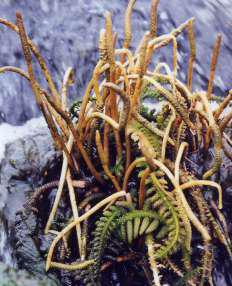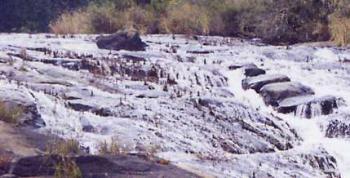Hydrostachys polymorpha
Hydrostachys polymorpha Klotzsch
Family: Hydrostachyaceae
Common names: white-waters plant (Eng.), phophoma-lasemanzini (Z)
Introduction
This unusual plant is unable to survive without the turbulence of water. It thrives in the white waters which give such a thrill to rafters. Living life on the edge, this plant has a formula for adhesion that enables it to cling to the rocks, better than any superglue on the market!

Description
Description
Hydrostachys polymorpha is a perennial herb that is securely attached to the rocks in waterfalls or rapids by numerous stiff, thread-like roots radiating from a round, discoid, compacted, woody stem. One to numerous fern-like, feathery leaves arise from this stem. The compound leaves are elliptical to lanceolate in outline, trailing or submerged in the water, and occasionally noticeable above the water surface.

The leaves are olive-green, about 15-75 cm long, subdivided into 2 or 3 pinnae, which are difficult to see because the small leaflets are curled up, giving the leaf a rough, warty appearance. The petiole and axis of the compound leaf are flat, covered with numerous wart-like or tongue-shaped outgrowths.

The male and female flowers are borne on separate plants, in fleshy, erect, stiff spikes that stand out above the water surface. The spikes are up to 30 cm long, with about 200 flowers borne in the axil of straw-coloured, fleshy bracts partially hiding the reduced flowers. There are no petals or sepals; the male flowers consist of a single stamen, while the female flower is a single ovary with two deep rose-pink styles extending beyond the bracts.
Very little is known about the biology of this plant. Thanks to Mr Mike Coke, formerly of the Natal Parks Board, several new localities were found in KwaZulu-Natal. From his observations and from information on herbarium sheets, it seems to flower mainly in May, when the rivers are receding. By the middle of August through to September, empty, stiff, dried, golden-yellow/greenish spikes can be seen protruding above the surface of the water. with numerous small fruits enclosed in the bracts. Cook (2004) assumes that the plant is wind-pollinated and that wind and water disperse the seeds, but this needs to be verified.
Conservation Status
Status
According to Scott-Shaw (1999), Hydrostachys polymorpha is vulnerable, occurring in very localised areas of the KwaZulu-Natal Midlands. Since so little is known about this unusual plant, the threats it faces still need to be established.
Distribution and habitat
Distribution description
Hydrostachys is endemic to tropical Africa and Madagascar. Two species occur in Africa, namely H. insignis found in Malawi, Tanzania, the DRC and Angola, and H. polymorpha which occurs in the DRC, Tanzania, Malawi, Zambia, Zimbabwe, Angola, Namibia, Mozambique and South Africa.
In South Africa H. polymorpha used to be known as H. natalensis, because it is confined to the midlands of KwaZulu-Natal, along the Lions, Luhane, Mkomazi, Umgeni, Umvoti and Molweni Rivers. It can be seen on the rocks at the Howick, Albert and Caversham Falls. The eastern-most distribution appears to be a waterfall on the Molweni River in the Krantzkloof Nature Reserve.
The next area where it occurs is on the Epupa and Ruacana Falls on the Kunene River.
Derivation of name and historical aspects
History
The genus name Hydrostachys is from the Greek, referring to the spikes sticking out of the water (hydro = water; stachys = a spike, referring here to the inflorescence sticking out of the water). The species name polymorpha means 'many shapes' (poly = many and morpha = shapes).
The Zulu name is phophoma-lasemanzini. Plants known as phophoma are used as love charms; lasemanzini means 'from the water', so the name means 'love charm from the water'.
Hydrostachys polymorpha does not have any English common names, but could possibly be referred to as the 'white-waters plant' or the 'super-stick plant'.
The family Hydrostachyaceae consists of the single genus Hydrostachys which contains 22 species.
According to herbarium records, the first plant was collected in 1887 by Medley-Wood, the founder of the KwaZulu-Natal Herbarium, along the Umvoti River in the vicinity of Greytown.
Where the family Hydrostachyaceae is placed in the dicotyledonous family tree and who its closest relatives are, are debatable. Based on floral morphology and habitat some botanists place it near the Podostemaceae. Embryological studies suggest a relationship with the Scrophulariales (the snapdragon order). Phytochemical studies suggested a close affiliation with other endemic South African families in the Bruniales (Scogin, R.1992). However, more recent studies using phylogenetic analyses of rbc L sequences revealed a close relationship with the order Cornales (Xiang, 1999).
Basically what this intricate and expensive research is revealing, is that Hydrostachys has adapted to survive in this special habitat where it has to compete with other plants, and it is important to find out more about what makes this plant 'tick' to enable us to conserve it.
Ecology
Ecology
Plants that are predestined to live in fast-flowing water, attached to the rocks of waterfalls or rapids, are referred to as haptophytes (hapto = hold on; phyte = plant). There are two families in the plant kingdom that have this type of growth form, namely Hydrostachyaceae and Podostemaceae.
In Hydrostachys the leaves are adapted to survive in fast-flowing water; the loose, dissected appearance of the leaves enables the water to flow through the leaves. A flat, entire leaf blade would be torn apart in the choppy water. Judging from the rich biodiversity of small organisms crawling around amongst the leaflets when a plant is collected, these leaves must be a haven for them. The structure of the leaves would furthermore act as a sieve and trap various small food particles on which these organisms can feed.

Uses
Use
The whole plant is used in traditional medicine and as love charms (Hutchings 1996).
Growing Hydrostachys polymorpha
Grow
This plant is not in cultivation, but offers a marvellous challenge for horticulturists. It would look stunning in a landscaped area on a modern man-made waterfall.
References
- Cook C.D.K. 2004. Aquatic and wetland plants of southern Africa. Barkhuys Publishers. Leiden.
- Hutchings, A. 1996. Zulu medicinal plants: an inventory. University of Natal Press, Pietermaritzburg.
- Scogin, R. 1992. Phytochemical profile of Hydrostachys insignis (Hydrostachyaceae). Aliso 13(3): 471-474.
- Scott-Shaw, R. 1999. Rare and threatened plants of KwaZulu-Natal and neighbouring regions. KwaZulu-Natal Conservation Service, Pietermaritzburg.
- Xiang, Q-Y 1999. Systematic affinities of Grubbiaceae and Hydrostachyaceae with in Cornales - insights from rbc L sequences. Harvard Papers in Botany 4 (2) 527-542
Credits
René Glen
KwaZulu-Natal Herbarium
November 2004
Plant Attributes:
Plant Type: Aquatic
SA Distribution: KwaZulu-Natal
Soil type:
Flowering season: Winter
PH:
Flower colour: Pink
Aspect:
Gardening skill: Challenging
Special Features:
Horticultural zones







Rate this article
Article well written and informative
Rate this plant
Is this an interesting plant?
Login to add your Comment
Back to topNot registered yet? Click here to register.